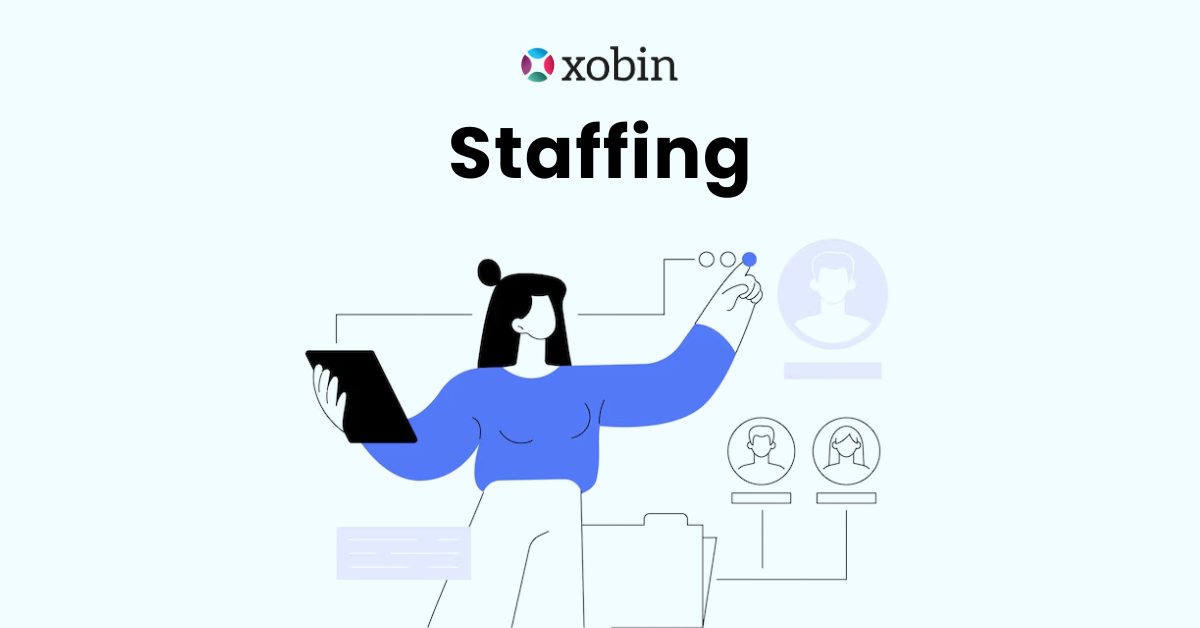XOBIPEDIA
HR Glossary

Table of Contents
Staffing is the backbone of every successful organization, yet many businesses struggle with skill shortages, high attrition, and poor hiring decisions. In simple terms, staffing is the process of identifying, attracting, selecting, onboarding, and retaining the right people for the right roles at the right time.
TL;DR
- Staffing ensures the right talent is available to meet business goals.
- It covers workforce planning, recruitment, selection, onboarding, and retention.
- Poor staffing leads to high turnover, low productivity, and increased hiring costs.
- Modern staffing is data-driven, skills-first, and powered by assessments and analytics.
- Strategic staffing improves workforce quality and business agility.
What Is Staffing in HR?
In HR terminology, staffing refers to the end-to-end process of building and maintaining an organization’s workforce. It goes beyond just hiring. Staffing includes forecasting talent needs, sourcing candidates, evaluating skills, onboarding employees, and ensuring the workforce continues to meet evolving business demands.
Traditionally, staffing was reactive; roles opened, and recruiters filled them. However, modern staffing is proactive and strategic. Organizations now plan staffing based on future skills, market trends, and business expansion. This shift helps companies avoid talent gaps, reduce hiring risks, and stay competitive.
For leadership teams, staffing is not an operational task; it’s a strategic lever. The quality of staffing decisions determines how fast teams can execute, innovate, and scale.
Key Objectives of Staffing
Right Person, Right Job
The primary goal of staffing is alignment, which is matching a candidate’s skills, experience, and behavior with job requirements. When this alignment is weak, even talented employees struggle to perform, leading to disengagement and attrition.
Workforce Optimization
Staffing ensures optimal utilization of human resources. Overstaffing increases costs, while understaffing leads to burnout and missed deadlines. Strategic staffing balances workload, cost, and productivity.
Business Continuity and Growth
Organizations grow, pivot, or restructure constantly. Effective staffing ensures continuity during change by having the right talent ready for new roles, technologies, and markets.

The Staffing Process Explained Step by Step
The staffing process follows a structured flow. While steps may vary by organization, the core stages remain the same.
1. Workforce Planning
Everything starts with planning. HR teams analyze current workforce gaps and future requirements. This stage aligns staffing with business goals and budgets.
2. Job Analysis and Role Definition
Next comes defining what success looks like in a role. Clear job descriptions, required skills, and competencies are outlined. This step sets expectations for both recruiters and candidates.
3. Recruitment
This is where recruitment and selection begin. Candidates are sourced through job portals, social media, referrals, and internal databases. A wider talent pool increases the chances of finding the right fit.
4. Assessment and Selection
Here is where modern staffing shines. Instead of relying only on resumes, organizations use pre-employment assessment tools to evaluate skills, aptitude, and job readiness. This stage ensures hiring decisions are based on data, not gut feelings.
💡 Pro Tip: Organizations using skill-based assessments report up to a 30–40% reduction in bad hires, according to industry hiring studies.
5. Onboarding and Placement
Once selected, candidates are onboarded and placed into roles. Smooth onboarding helps new hires settle in quickly and perform better from day one.
6. Retention and Performance Tracking
Staffing does not stop at hiring. Continuous performance reviews and engagement strategies ensure employees grow and stay aligned with organizational goals.
Types of Staffing Models You Should Know
Permanent Staffing
This involves hiring full-time employees for long-term roles. It offers stability, cultural alignment, and deep organizational knowledge but requires higher investment.
Temporary and Contract Staffing
Used for short-term projects or seasonal demand. This staffing model provides flexibility and cost control but may impact continuity.
Project-Based and Gig Staffing
Increasingly popular in tech and digital roles, this model allows organizations to access niche skills quickly without long-term commitments.
Internal Staffing
Filling roles through promotions or lateral moves improves retention and morale while reducing hiring costs.
Staffing vs. Recruitment: Key Difference
While often used interchangeably, staffing and recruitment are not the same.
| Aspect | Staffing | Recruitment |
| Scope | End-to-end workforce management | Focused on hiring |
| Timeline | Ongoing and strategic | Short-term and role-specific |
| Focus | Long-term talent alignment | Filling open positions |
| Business Impact | High, strategic | Operational |
Recruitment is a subset of staffing, not the other way around.
Common Staffing Challenges
- Skill Mismatch: Hiring based on resumes instead of validated skills leads to poor performance and early exits.
- Hiring Bias: Unstructured interviews and gut-based decisions introduce bias, reducing diversity and fairness.
- High Attrition: Poor staffing decisions often surface as high turnover within the first 6–12 months.
- Slow Time-to-Hire: Manual screening and inefficient processes delay hiring, affecting business delivery.
Addressing these challenges requires structured assessments, automation, and data-backed decision-making.
Staffing Done Right with Xobin!
Staffing is not just an HR function. It is a business strategy. When done right, it builds strong teams, fuels growth, and reduces hiring risks.
At Xobin, we help organizations transform staffing with science-backed, skill-based assessments. Our platform enables recruiters and leaders to hire faster, smarter, and fairer.
- Evaluate skills objectively
- Predict job performance
- Reduce hiring bias
- Improve time-to-hire
- Make data-driven workforce decisions
Looking to modernize your staffing strategy? Xobin’s AI-powered skill assessments, psychometric tests, and proctoring help you build high-performing teams faster and with confidence.
FAQs
What is staffing in simple terms?
Staffing is the process of finding, hiring, placing, and retaining the right employees to meet business needs.
How is staffing different from recruitment?
Recruitment focuses only on hiring, while staffing covers the entire employee lifecycle, including planning, selection, onboarding, and retention.
Why is staffing important for organizations?
Effective staffing improves productivity, reduces turnover, controls costs, and ensures business continuity.
What are the main types of staffing?
Permanent staffing, temporary staffing, contract staffing, project-based staffing, and internal staffing.
How can companies improve their staffing process?
By adopting skills-based hiring, structured assessments, data-driven workforce planning, and technology-enabled evaluations.
What role do assessments play in staffing?
Assessments validate candidate skills and behavior, reducing hiring bias and improving job-fit accuracy.

Recommended Content

Video Interviews can simplify your hiring
Don’t let a packed schedule be a hindrance in recruitment. Use structured interviews with the power of video to screen applicants. Understand the communication skills, motivation, and job skills using video interviews.

Pre-employment Testing: The Complete Guide
Move over from pen-paper based tests and manually checked assignments to pre-employment assessments. Democratize your organization hiring by screening for skills before you interview.

How can Employers adapt to Remote Hiring
With most jobs going remote, your best applicants could be in Melbourne or Miami. From remote screening and virtual interviews to remote onboarding, Learn the best practices to get started.


